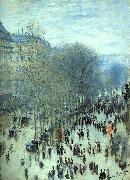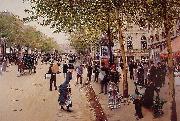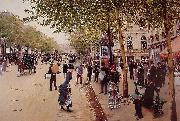Wholesale Oil Painting Reproductions No Minimum and Door to Door! |
|||||||||||
|
|
|||||||||||

|
|||||||||||
|
|
|
||||||||
All Claude Monet Oil Paintings |
||||||||
|
|
||||||||
|
|
||||||||
|
Artist Introduction: French Impressionist Painter, 1840-1926
Claude Oscar Monet (14 November 1840 C 5 December 1926) was a founder of French impressionist painting, and the most consistent and prolific practitioner of the movement's philosophy of expressing one's perceptions before nature, especially as applied to plein-air landscape painting. The term Impressionism is derived from the title of his painting.
Claude Monet was born on 14 November 1840 on the fifth floor of 45 rue Laffitte, in the ninth arrondissement of Paris . He was the second son of Claude-Adolphe and Louise-Justine Aubree Monet, both of them second-generation Parisians. On 20 May 1841, he was baptised into the local church parish, Notre-Dame-de-Lorette as Oscar-Claude. In 1845, his family moved to Le Havre in Normandy. His father wanted him to go into the family grocery store business, but Claude Monet wanted to become an artist. His mother was a singer.
On the first of April 1851, Monet entered the Le Havre secondary school of the arts. He first became known locally for his charcoal caricatures, which he would sell for ten to twenty francs. Monet also undertook his first drawing lessons from Jacques-François Ochard, a former student of Jacques-Louis David. On the beaches of Normandy in about 1856/1857 he met fellow artist Eugene Boudin who became his mentor and taught him to use oil paints. Boudin taught Monet "en plein air" (outdoor) techniques for painting.
On 28 January 1857 his mother died. He was 16 years old when he left school, and went to live with his widowed childless aunt, Marie-Jeanne Lecadre.
After several difficult months following the death of Camille on 5 September 1879, a grief-stricken Monet (resolving never to be mired in poverty again) began in earnest to create some of his best paintings of the 19th century. During the early 1880s Monet painted several groups of landscapes and seascapes in what he considered to be campaigns to document the French countryside. His extensive campaigns evolved into his series' paintings.
Camille Monet had become ill with tuberculosis in 1876. Pregnant with her second child she gave birth to Michel Monet in March 1878. In 1878 the Monets temporarily moved into the home of Ernest Hosched, (1837-1891), a wealthy department store owner and patron of the arts. Both families then shared a house in Vetheuil during the summer. After her husband (Ernest Hoschede) became bankrupt, and left in 1878 for Belgium, in September 1879, and while Monet continued to live in the house in Vetheuil; Alice Hosched helped Monet to raise his two sons, Jean and Michel, by taking them to Paris to live alongside her own six children. They were Blanche, Germaine, Suzanne, Marthe, Jean-Pierre, and Jacques. In the spring of 1880 Alice Hosched and all the children left Paris and rejoined Monet still living in the house in Vetheuil. In 1881 all of them moved to Poissy which Monet hated. From the doorway of the little train between Vernon and Gasny he discovered Giverny. In April 1883 they moved to Vernon, then to a house in Giverny, Eure, in Upper Normandy, where he planted a large garden where he painted for much of the rest of his life. Following the death of her estranged husband, Alice Hosched married Claude Monet in 1892.
|
||||||||
|
|
||||||||
|
Boulevard des Capucines Painting ID:: 2968 |
1873
80 x 60cm
The Nelson-Atkins Museum of Art, Kansas
|
|||||||
Height Width |
INS/CM Quality |
|||||||
|
X |
| |||||||
|
|
||||||||
All Jean Beraud Oil Paintings |
||||||||
|
|
||||||||
|
|
||||||||
|
Artist Introduction: 1848-1935
French
Jean Beraud Galleries
Berauds father (also called Jean) was a sculptor and was likely working on the site of St. Isaacs Cathedral at the time of his sons birth. Berauds mother was one Genevieve Eugenie Jacquin; following the death of Beraudes father the family moved to Paris. B??raud was in the process of being educated as a lawyer until the occupation of Paris during the Franco-Prussian war in 1870.
Beraud became a student of Leon Bonnat, and exhibited his paintings at the Salon for the first time in 1872, however he only gained recognition in 1876, with his On the Way Back from the Funeral. He exhibited with the Society of French Watercolorists at the 1889 Worldes Fair in Paris. He painted many scenes of Parisian daily life during the Belle epoque, in a style that stands somewhere between the academic art of the Salon and that of the Impressionists. He received the Legion d honneur in 1894.
Berauds paintings often included truth based humour and mockery of late 19th century Parisian life. Along with frequent appearances of biblical characters in then contemporary situations. Paintings such as Mary Magdalene in the House of the Pharisees aroused controversy when exhibited because of these themes.
Towards the end of the 19th century Beraud dedicated less time to his own painting, but worked in numerous exhibition committees including the Salon de la Societe Nationale.
Beraud never married and has no children, he is buried in Montparnasse Cemetery beside his mother. |
||||||||
|
|
||||||||
|
|
Boulevard des capucines Painting ID:: 85503 |
Medium Oil on canvas
Dimensions 50.8 x 73 cm (20 x 28.7 in)
cjr |
||||||
Height Width |
INS/CM Quality |
|||||||
|
X |
| |||||||
|
|
||||||||
All Jean Beraud Oil Paintings |
||||||||
|
|
||||||||
|
|
||||||||
|
Artist Introduction: 1848-1935
French
Jean Beraud Galleries
Berauds father (also called Jean) was a sculptor and was likely working on the site of St. Isaacs Cathedral at the time of his sons birth. Berauds mother was one Genevieve Eugenie Jacquin; following the death of Beraudes father the family moved to Paris. B??raud was in the process of being educated as a lawyer until the occupation of Paris during the Franco-Prussian war in 1870.
Beraud became a student of Leon Bonnat, and exhibited his paintings at the Salon for the first time in 1872, however he only gained recognition in 1876, with his On the Way Back from the Funeral. He exhibited with the Society of French Watercolorists at the 1889 Worldes Fair in Paris. He painted many scenes of Parisian daily life during the Belle epoque, in a style that stands somewhere between the academic art of the Salon and that of the Impressionists. He received the Legion d honneur in 1894.
Berauds paintings often included truth based humour and mockery of late 19th century Parisian life. Along with frequent appearances of biblical characters in then contemporary situations. Paintings such as Mary Magdalene in the House of the Pharisees aroused controversy when exhibited because of these themes.
Towards the end of the 19th century Beraud dedicated less time to his own painting, but worked in numerous exhibition committees including the Salon de la Societe Nationale.
Beraud never married and has no children, he is buried in Montparnasse Cemetery beside his mother. |
||||||||
|
|
||||||||
|
|
Boulevard des capucines Painting ID:: 89608 |
oil on canvas
Dimensions 50.8 x 73 cm (20 x 28.7 in)
cyf |
||||||
Height Width |
INS/CM Quality |
|||||||
|
X |
| |||||||
|
|
||||||||
|
Prev Next
|
||||||||
|
|
||||||||
|
Related Paintings to Jean Beraud :. |
||||||||
|
|
||||||||
|
CONTACT US |



